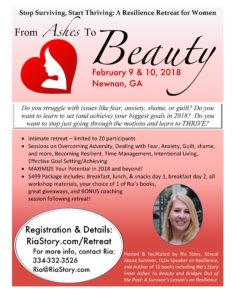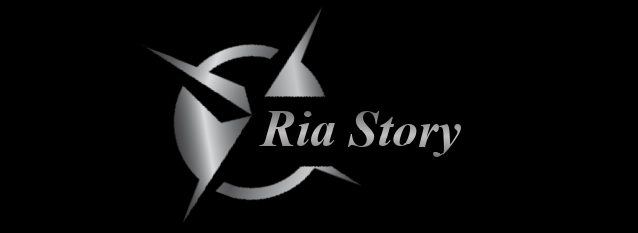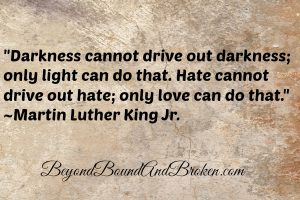Living life on purpose requires us to be intentional. Far too often when we aren’t being intentional, we end up wasting our precious time and energy on things we don’t really want or need in our lives. And, it’s difficult – scratch that: it’s impossible – to become your ULTIMATE self, when you aren’t living life on purpose. It’s also impossible to become resilient without becoming intentional. No one accidentally becomes the best version of themselves.
Note: This is an excerpt of Ria’s new book, Bridges out of the Past, and is the second article of a four-part series on Resilience. Find part 1 here.
The first step toward becoming intentional is to identify what we are going to be intentional about. It’s unfortunate that our natural “Fight, Flight, or Freeze” responses often deter us from using our most valuable resource: our mind.
George Bernard Shaw stated it well, “The people who get on in this world are the people who get up and look for the circumstances they want, and if they can’t find them, make them.”
Identify Accurately: Where are you, where do you want to go, and how will you get there?
If we don’t know where we are or where we’re going, how will we know when we reach our destination? How will we determine if we’re moving in the right direction? Or worse, will we even know or care which direction we are heading? Truthfully, until we know where we want to go, it doesn’t really matter where we are or which way we’re heading.
Resilient leaders (people) identify where they want to go, where they are, and then identify the steps they must take in order to move from where they are to where they want to be.
I started my career working as a waitress in a pizza restaurant making $2.13 an hour plus tips. My first paycheck was more than a paycheck, it was also a reality check.
Even when working full-time, any tips I earned were then deducted from my $2.13 an hour paycheck. As a result, some of my paychecks totaled less than $20.00 after taxes for two weeks of hard work.
At that time, I wasn’t really sure what my dream job was, but I did realize it wouldn’t come looking for me. I was going to have to go looking for it.
Regardless of where you have come from and where you are now, you do not have to stay there.
Most often, it’s not our physical circumstances that keep us stuck. It’s our emotional circumstances that do all the damage. As Daniel Goleman said, “Self-awareness – recognizing a feeling as it happens – is the keystone of emotional intelligence.”
Self-awareness is also the key to understanding when we’re moving in the right direction. The biggest obstacle to achieving anything in our lives is the false assumption that we cannot achieve what we want to achieve. Then, based on those false beliefs, we create our reality.
Increasing your self-awareness isn’t easy. It requires you to do the difficult work of determining your values, reflecting on them, and then evaluating them in order to determine how they have influenced your thoughts, decisions, choices, actions, consequences, and ultimately, how they have created your current circumstances.
You should do this exercise intentionally for all four dimensions of your life: Physical, Relational, Emotional, and Spiritual. Until you are able to accurately identify where you are in your life and where you want to go in your life, you won’t be able to figure out how to get there.
In the physical dimension of your life, take a few moments and honestly reflect on where you are in terms of physical health and wellness. Do you exercise regularly? Are you healthy? Do you have bad health habits that are taking years off of your life?
Then, reflect on where you want to be and what you should start doing differently reach you goal. I don’t mean imagine a picture perfect body like you saw on the cover of a magazine. I do mean truly reflect on what your “ideal physical healthy state” should be and what that would look like for you compared to where you actually are today.
The concept is that once you honestly know where you are now and where you truly want to be, you have identified the gap and can stop making excuses and start accepting responsibility for closing that gap.
Where are you in terms of your relational life? Do you have positive relationships with people who support you? Are there harmful, toxic, or negative relationships that you need to terminate? Most often, the people closest to us are the ones holding us back the most because they have the most influence in our lives.
The most powerful example from my life was my father and mother. They held me back more than anyone else ever has or will. They should have been supporting me the most, but they chose not to support me at all. People who aren’t close to us have little, if any, influence in our lives. Be careful and focus most on those who are closest to you.
Sometimes, we need to end or change relationships with one or more of those who are closest to us. It doesn’t necessarily mean the people are bad. It does mean it’s a relationship that doesn’t support you, your growth, and your goals.
I was on a coaching call this recently with one of my clients. She has determined she wants to build more relationships. To help raise her self-awareness about what that meant, I encouraged and questioned her, “That’s great! But, what kind of relationships do you want to create and with whom?”
Where are you in terms of your emotional life? Are you happy? Are you sad? Is your life full of joy? Is your life full of drama? Are you growing? Are you slowing? Are you fulfilled? Are you drained? What thoughts are you having about your life? What thoughts should you be having? As James Allen remarked, “The outer word of circumstance shapes itself to the inner world of thought.”
 Where are you in your spiritual life? Do you make time for reflection, prayer, or meditation? Is there balance and harmony in your life? Is there chaos in your life? Are you in alignment with why you are here? Is your relationship with God alive?
Where are you in your spiritual life? Do you make time for reflection, prayer, or meditation? Is there balance and harmony in your life? Is there chaos in your life? Are you in alignment with why you are here? Is your relationship with God alive?
Once you Identify Accurately what success looks like, you will be positioned to know what must be done to convert that image of success in your mind into a reality in your life. For example, if you want to run a marathon, you need to honestly identify what your current physical state is. Assuming it’s physically possible for you to run, then you need to identify what is required of you to achieve that goal. Next, identify the healthy choices a person who wants to run a marathon would make such as: eating nutritiously, resting and sleeping diligently, and training hard consistently and methodically.
Knowing what to do is no longer an issue. Now, you must act. You can and must make it happen, or it’s not going to happen. No one can do it for you but you.
The question you must now answer is, “Am I truly willing to commit to those choices?” Do it, and you will reach your goal. Don’t do it, and you won’t. It’s really that simple. But, it’s not that easy.

